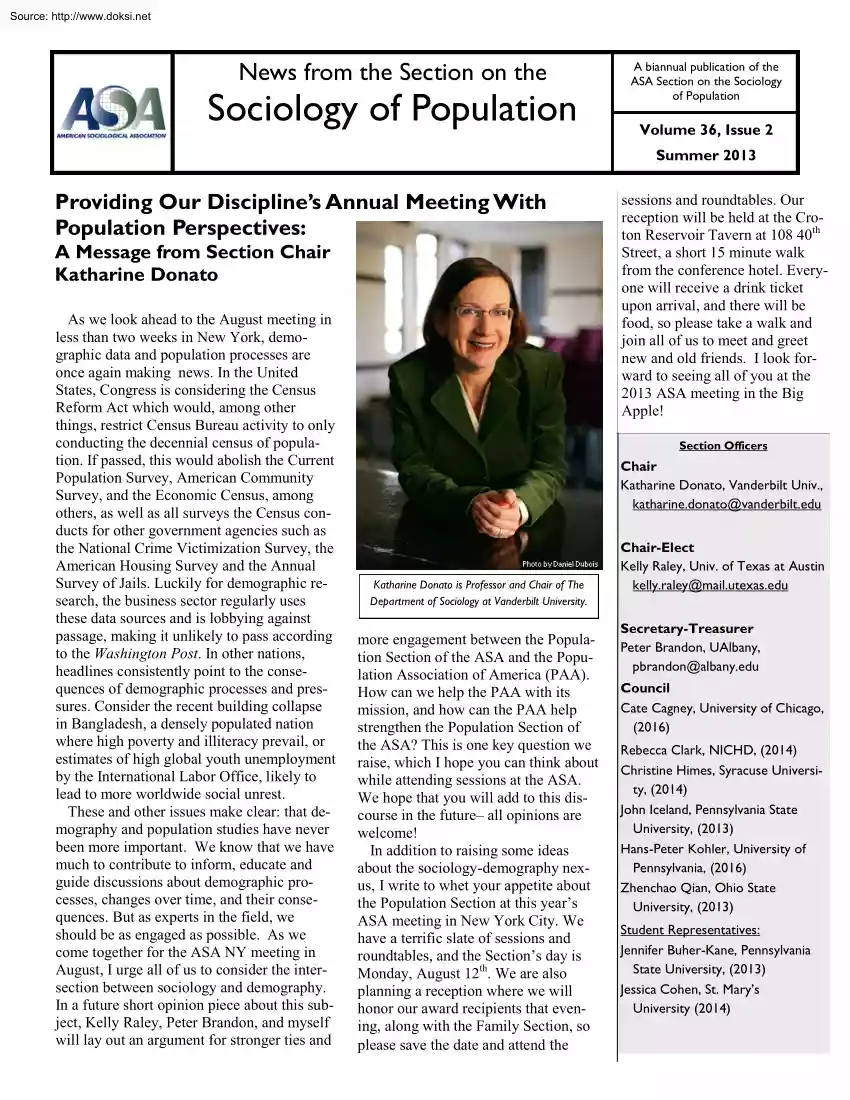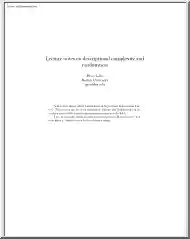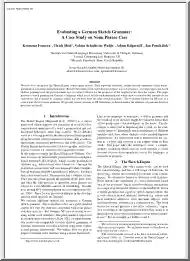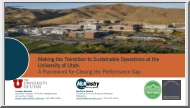A doksi online olvasásához kérlek jelentkezz be!

A doksi online olvasásához kérlek jelentkezz be!
Nincs még értékelés. Legyél Te az első!
Mit olvastak a többiek, ha ezzel végeztek?
Tartalmi kivonat
Source: http://www.doksinet News from the Section on the Sociology of Population A biannual publication of the ASA Section on the Sociology of Population Volume 36, Issue 2 Summer 2013 Providing Our Discipline’s Annual Meeting With Population Perspectives: A Message from Section Chair Katharine Donato As we look ahead to the August meeting in less than two weeks in New York, demographic data and population processes are once again making news. In the United States, Congress is considering the Census Reform Act which would, among other things, restrict Census Bureau activity to only conducting the decennial census of population. If passed, this would abolish the Current Population Survey, American Community Survey, and the Economic Census, among others, as well as all surveys the Census conducts for other government agencies such as the National Crime Victimization Survey, the American Housing Survey and the Annual Survey of Jails. Luckily for demographic research, the business
sector regularly uses these data sources and is lobbying against passage, making it unlikely to pass according to the Washington Post. In other nations, headlines consistently point to the consequences of demographic processes and pressures. Consider the recent building collapse in Bangladesh, a densely populated nation where high poverty and illiteracy prevail, or estimates of high global youth unemployment by the International Labor Office, likely to lead to more worldwide social unrest. These and other issues make clear: that demography and population studies have never been more important. We know that we have much to contribute to inform, educate and guide discussions about demographic processes, changes over time, and their consequences. But as experts in the field, we should be as engaged as possible. As we come together for the ASA NY meeting in August, I urge all of us to consider the intersection between sociology and demography. In a future short opinion piece about this
subject, Kelly Raley, Peter Brandon, and myself will lay out an argument for stronger ties and sessions and roundtables. Our reception will be held at the Croton Reservoir Tavern at 108 40th Street, a short 15 minute walk from the conference hotel. Everyone will receive a drink ticket upon arrival, and there will be food, so please take a walk and join all of us to meet and greet new and old friends. I look forward to seeing all of you at the 2013 ASA meeting in the Big Apple! Section Officers Chair Katharine Donato, Vanderbilt Univ., katharine.donato@vanderbiltedu Katharine Donato is Professor and Chair of The Department of Sociology at Vanderbilt University. more engagement between the Population Section of the ASA and the Population Association of America (PAA). How can we help the PAA with its mission, and how can the PAA help strengthen the Population Section of the ASA? This is one key question we raise, which I hope you can think about while attending sessions at the ASA. We
hope that you will add to this discourse in the future– all opinions are welcome! In addition to raising some ideas about the sociology-demography nexus, I write to whet your appetite about the Population Section at this year’s ASA meeting in New York City. We have a terrific slate of sessions and roundtables, and the Section’s day is Monday, August 12th. We are also planning a reception where we will honor our award recipients that evening, along with the Family Section, so please save the date and attend the Chair-Elect Kelly Raley, Univ. of Texas at Austin kelly.raley@mailutexasedu Secretary-Treasurer Peter Brandon, UAlbany, pbrandon@albany.edu Council Cate Cagney, University of Chicago, (2016) Rebecca Clark, NICHD, (2014) Christine Himes, Syracuse University, (2014) John Iceland, Pennsylvania State University, (2013) Hans-Peter Kohler, University of Pennsylvania, (2016) Zhenchao Qian, Ohio State University, (2013) Student Representatives: Jennifer Buher-Kane, Pennsylvania
State University, (2013) Jessica Cohen, St. Mary’s University (2014) Source: http://www.doksinet Volume 36, Issue 2 Page 2 A Short History of the ASA Section on the Sociology of Population By Charles B. Nam and Dudley L Poston, Jr In the early 1970s, the American Sociological Association enabled within the association the development of “sections,” which the ASA defined as “officially-recognized assemblies of ASA members who share interests in a specific sociological topic.” At that time several members of the ASA (not including the above authors) formed a “Section on Population.” The members were primarily demographers and sociologists with strong ties to the Population Association of America (PAA). The program sessions they developed almost always emphasized topics and interests that were central to demography per se. After a couple of years, a motion was made at the “Section on Population” business meeting that the Section be terminated on the grounds that it
duplicated programs at PAA. The motion passed and the Section was disbanded For several years, thus, the ASA did not have a specific section focused on demography. And those were the years when sections grew in number and importance within ASA. In 1977, a group of demographers (including the above authors) met informally and agreed that the earlier ASA Section on the Sociology of Population 2012-2013 Section Chair Katharine M. Donato Professor and Chair, Department of Sociology Vanderbilt University 321G Garland Hall VU Station B351811 Nashville TN 37235-1811 Email: katharine.donato@vanderbiltedu “Section on Population” had failed because it did not emphasize satisfactorily sociology’s link to population. This ad-hoc group, headed by Charles Nam, thus moved to begin a new section for demographers in ASA, one that specifically focused on the relationships and links between sociology and demography, i.e, “sociological demography” or “social demography,” if you will.
Oldtimers will remember the distinction made in 1959 by Philip Hauser and Otis Dudley Duncan between "demographic analysis" and "population studies." Our thinking when the section was reorganized was that we would focus much more on “population studies” than on “demographic analysis.” Therefore, we proposed that the section be named the “Section on the Sociology of Population.” This ad-hoc group and the section officers for the first few years included the above authors and such other social demographers as Kingsley Davis, Paul Glick, Michael Micklin, Daniel Price, Linda Waite, Reynolds Farley, Harriet Presser, Mary Powers, Valerie Oppenheimer, Wendy Baldwin, Monica Boyd, Larry Bumpass, Mary Kritz, Marta Tienda, Basil Zimmer, Arland Thornton, Larry Long, Teresa Sullivan and Judy Treas. Nam was elected as the first chair (1978) of the newly organized Section on the Sociology of Population; the chairs of the Section for the next few years were Dan Price
(1979), Reynolds Farley (1980), Valerie Oppenheimer (1981), Larry Bumpass (1982), Harriet Presser (1983), Dudley Poston (1984), and Mary Powers (1985). When the new Section was approved in 1978, the ad-hoc group insisted that it be named the Section on the Sociology of Population, and the purpose and by-laws indicated this Section focus. Subsequently, we have been reminded that on at least two occasions since 1978, the ASA staff has inadvertently dropped “the Sociology of” part of the title; but the staff has been reminded by Section members why it had to be there. For nearly thirty-five years now, the Section on the Sociology of Population has functioned well and has expanded its member base to over 500. From time to time program planners have occasionally lost sight of the main purpose of the Section, but in the whole it has been true to its purpose. The purpose of the Section on the Sociology of Population is to foster the development of the study of population within the
context of sociology. As of July 1, 2013, the section has 471 members, including 92 student members. Keep recruiting more students! Access section information online at: www2.asanetorg/population/
sector regularly uses these data sources and is lobbying against passage, making it unlikely to pass according to the Washington Post. In other nations, headlines consistently point to the consequences of demographic processes and pressures. Consider the recent building collapse in Bangladesh, a densely populated nation where high poverty and illiteracy prevail, or estimates of high global youth unemployment by the International Labor Office, likely to lead to more worldwide social unrest. These and other issues make clear: that demography and population studies have never been more important. We know that we have much to contribute to inform, educate and guide discussions about demographic processes, changes over time, and their consequences. But as experts in the field, we should be as engaged as possible. As we come together for the ASA NY meeting in August, I urge all of us to consider the intersection between sociology and demography. In a future short opinion piece about this
subject, Kelly Raley, Peter Brandon, and myself will lay out an argument for stronger ties and sessions and roundtables. Our reception will be held at the Croton Reservoir Tavern at 108 40th Street, a short 15 minute walk from the conference hotel. Everyone will receive a drink ticket upon arrival, and there will be food, so please take a walk and join all of us to meet and greet new and old friends. I look forward to seeing all of you at the 2013 ASA meeting in the Big Apple! Section Officers Chair Katharine Donato, Vanderbilt Univ., katharine.donato@vanderbiltedu Katharine Donato is Professor and Chair of The Department of Sociology at Vanderbilt University. more engagement between the Population Section of the ASA and the Population Association of America (PAA). How can we help the PAA with its mission, and how can the PAA help strengthen the Population Section of the ASA? This is one key question we raise, which I hope you can think about while attending sessions at the ASA. We
hope that you will add to this discourse in the future– all opinions are welcome! In addition to raising some ideas about the sociology-demography nexus, I write to whet your appetite about the Population Section at this year’s ASA meeting in New York City. We have a terrific slate of sessions and roundtables, and the Section’s day is Monday, August 12th. We are also planning a reception where we will honor our award recipients that evening, along with the Family Section, so please save the date and attend the Chair-Elect Kelly Raley, Univ. of Texas at Austin kelly.raley@mailutexasedu Secretary-Treasurer Peter Brandon, UAlbany, pbrandon@albany.edu Council Cate Cagney, University of Chicago, (2016) Rebecca Clark, NICHD, (2014) Christine Himes, Syracuse University, (2014) John Iceland, Pennsylvania State University, (2013) Hans-Peter Kohler, University of Pennsylvania, (2016) Zhenchao Qian, Ohio State University, (2013) Student Representatives: Jennifer Buher-Kane, Pennsylvania
State University, (2013) Jessica Cohen, St. Mary’s University (2014) Source: http://www.doksinet Volume 36, Issue 2 Page 2 A Short History of the ASA Section on the Sociology of Population By Charles B. Nam and Dudley L Poston, Jr In the early 1970s, the American Sociological Association enabled within the association the development of “sections,” which the ASA defined as “officially-recognized assemblies of ASA members who share interests in a specific sociological topic.” At that time several members of the ASA (not including the above authors) formed a “Section on Population.” The members were primarily demographers and sociologists with strong ties to the Population Association of America (PAA). The program sessions they developed almost always emphasized topics and interests that were central to demography per se. After a couple of years, a motion was made at the “Section on Population” business meeting that the Section be terminated on the grounds that it
duplicated programs at PAA. The motion passed and the Section was disbanded For several years, thus, the ASA did not have a specific section focused on demography. And those were the years when sections grew in number and importance within ASA. In 1977, a group of demographers (including the above authors) met informally and agreed that the earlier ASA Section on the Sociology of Population 2012-2013 Section Chair Katharine M. Donato Professor and Chair, Department of Sociology Vanderbilt University 321G Garland Hall VU Station B351811 Nashville TN 37235-1811 Email: katharine.donato@vanderbiltedu “Section on Population” had failed because it did not emphasize satisfactorily sociology’s link to population. This ad-hoc group, headed by Charles Nam, thus moved to begin a new section for demographers in ASA, one that specifically focused on the relationships and links between sociology and demography, i.e, “sociological demography” or “social demography,” if you will.
Oldtimers will remember the distinction made in 1959 by Philip Hauser and Otis Dudley Duncan between "demographic analysis" and "population studies." Our thinking when the section was reorganized was that we would focus much more on “population studies” than on “demographic analysis.” Therefore, we proposed that the section be named the “Section on the Sociology of Population.” This ad-hoc group and the section officers for the first few years included the above authors and such other social demographers as Kingsley Davis, Paul Glick, Michael Micklin, Daniel Price, Linda Waite, Reynolds Farley, Harriet Presser, Mary Powers, Valerie Oppenheimer, Wendy Baldwin, Monica Boyd, Larry Bumpass, Mary Kritz, Marta Tienda, Basil Zimmer, Arland Thornton, Larry Long, Teresa Sullivan and Judy Treas. Nam was elected as the first chair (1978) of the newly organized Section on the Sociology of Population; the chairs of the Section for the next few years were Dan Price
(1979), Reynolds Farley (1980), Valerie Oppenheimer (1981), Larry Bumpass (1982), Harriet Presser (1983), Dudley Poston (1984), and Mary Powers (1985). When the new Section was approved in 1978, the ad-hoc group insisted that it be named the Section on the Sociology of Population, and the purpose and by-laws indicated this Section focus. Subsequently, we have been reminded that on at least two occasions since 1978, the ASA staff has inadvertently dropped “the Sociology of” part of the title; but the staff has been reminded by Section members why it had to be there. For nearly thirty-five years now, the Section on the Sociology of Population has functioned well and has expanded its member base to over 500. From time to time program planners have occasionally lost sight of the main purpose of the Section, but in the whole it has been true to its purpose. The purpose of the Section on the Sociology of Population is to foster the development of the study of population within the
context of sociology. As of July 1, 2013, the section has 471 members, including 92 student members. Keep recruiting more students! Access section information online at: www2.asanetorg/population/



